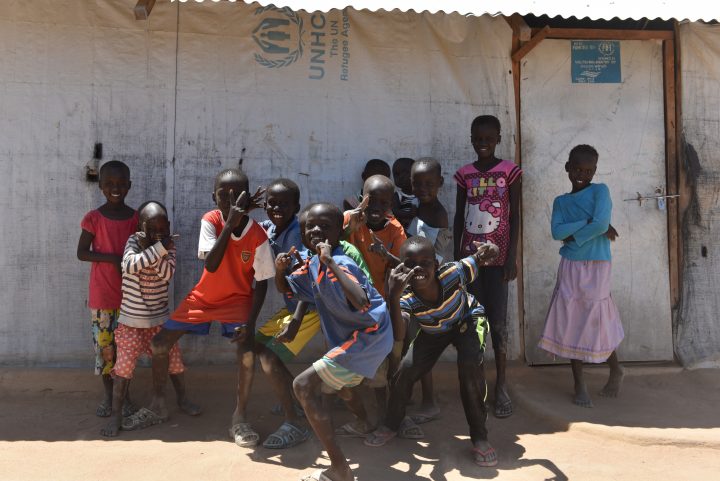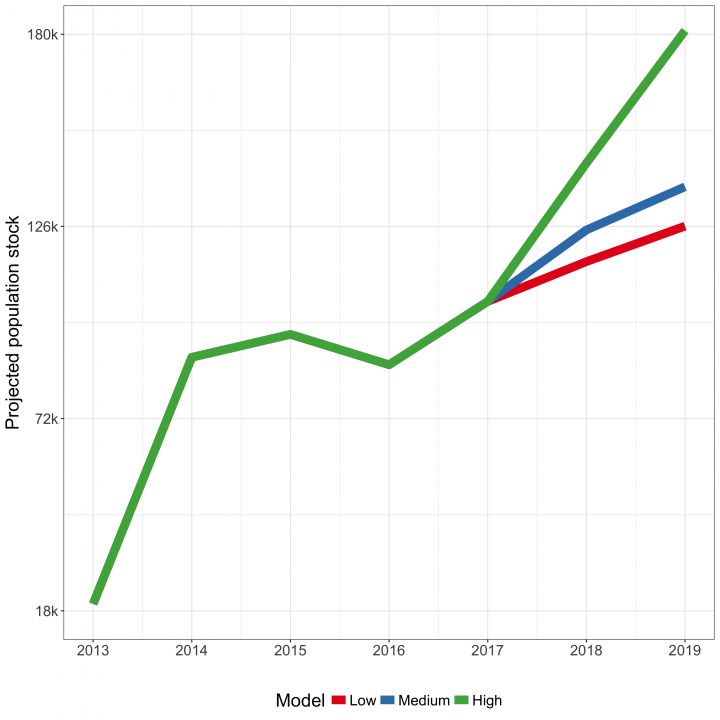By Diego Alburez-Gutierrez, UNHCR Field Information and Coordination Support Section (FICSS). This blog was originally published on UNHCR Innovation Service site.

Refugee children from South Sudan pose for a photo in their residential house in Ifo 2 camp, one the four camps in Dadaab.
UNHCR provides crucial support to forcibly displaced populations around the world, including access to shelter and basic services. Coordinating these activities requires data about the individuals under UNHCR’s mandate. The number of persons of concern to UNHCR (PoC) has risen steadily since the end of World War Two and there are now around 66 million individuals under the agency’s mandate. Knowing how this population will evolve in the future is crucial for conducting cost-effective and efficient planning strategies. However, projecting the future of forced migration is difficult given that the political, economic, and social factors that shape displacement are extremely volatile. Will a new conflict erupt in the Middle East? When will acceptable solutions be found for the Rohingya refugees in Bangladesh?
UNHCR field operations routinely provide estimates of the future number of PoC in the countries where they operate, but there is currently no consensus or standardised guidance on how these projections should be made. In practice, they result from a combination of experience and intuition. Yet, the lack of a standard approach means that the process often lacks transparency. As a response to this challenge, the Field Information and Coordination Support Section (FICSS) at UNHCR, funded by ECHO, developed a tool for creating scientific population projections of PoC using simple demographic principles. The Demographic Projection Tool (DPTool) was born in this way, inspired by a software that UNAids has used extensively to project HIV prevalence (Spectrum).
The easiest way of explaining how the DPTool works is by looking at a specific case. In this example, we are interested in estimating the size of the population of South Sudanese refugees in Kenya for 2018. Thanks to UNHCR registration data, we know that this population had around one hundred thousand members at the start of 2017. Therefore, it is logical to assume that the population alive at the start of 2018 will be equal to the 2017 population plus all the new births that happened in between and the new arrivals, minus the number of deaths and departures. The DPTool applies this simple principle (known as the demographic balancing equation) to model different scenarios about the future size and composition of the refugee population.
The DPTool uses data that are already available to UNHCR field operations. The UN Refugee Agency routinely collects information about individuals under its mandate during registration processes. Field operations have access to anonymised versions of this data, after multiple mechanisms are put in place to ensure data security and to protect the privacy of PoC. This information is fed into the DPTool, which then estimates the future number of PoC applying different assumptions about the number of births, deaths, and the magnitude of forced migration in the future. The tool provides evidence-based projections about changes in the populations of displaced individuals, but it is not perfect. On the one hand, the DPTool cannot predict the future events that may affect displacement, such as elections or new armed conflicts. Therefore, the tool only works well if the contextual conditions of a humanitarian emergency remain the same. This means that the DPTool is better-suited for short-term projections. For the same reason, the tool continues to rely heavily on UNHCR personnel who must define the parameters of the model based on their expert knowledge of the situation on the field. The projection tool will be shared with UNHCR field operations in the near future for them to use it in this year’s planning and in forthcoming planning exercises.

Total size of refugee stock with different assumptions about forced displacement.
This project originated from UNHCR’s need to provide scientific estimates about the number of refugees, IDPs, etc. that will require protection in the years to come. In the course of its development, it became evident that innovation is not necessarily synonymous with new technology. As a matter of fact, the projection tool uses methodologies developed a long time ago. Rather, the concept was original because it connected these established techniques with the unique data available to UNHCR. Sometimes, innovating implies using an established approach to solve a new problem.
“The UNHCR Demographic Projection Tool can be accessed online: http://DemographicProjection.unhcr.org/
A detailed description of the tool was published as part of the UNHCR statistics technical series: http://www.unhcr.org/statistics/unhcrstats/59bbeb384/unhcr-statistics-technical-series.html
